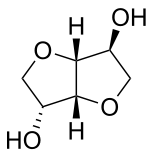Isosorbide
 | |
| Names | |
|---|---|
| Other names
D-Isosorbide; 1,4:3,6-Dianhydro-D-sorbitol; 1,4-Dianhydrosorbitol | |
| Identifiers | |
| 652-67-5 | |
| ChEMBL | ChEMBL1200660 |
| ChemSpider | 12077 |
| |
| Jmol-3D images | Image |
| KEGG | D00347 |
| PubChem | 12597 |
| |
| Properties | |
| Molecular formula |
C6H10O4 |
| Molar mass | 146.14 g·mol−1 |
| Appearance | Highly hygroscopic white flakes |
| Density | 1.30 at 25 °C |
| Melting point | 62.5 °C (144.5 °F; 335.6 K) |
| Boiling point | 160 °C (320 °F; 433 K) at 10 mmHg |
| in water (>850 g/L), alcohols and ketones | |
| Except where noted otherwise, data is given for materials in their standard state (at 25 °C (77 °F), 100 kPa) | |
| | |
| Infobox references | |
Isosorbide is a heterocyclic compound that is derived from glucose. Isosorbide and its two isomers, namely isoidide and isomannide, are 1,4:3,6-dianhydrohexitols. It is a white solid that is prepared from the double dehydration of sorbitol. Isosorbide is a non-toxic diol produced from biobased feedstocks, that is biodegradable and thermally stable. It is used in medicine and has been touted as a potential biofeedstock.
Production
Hydrogenation of glucose gives sorbitol. Isosorbide is obtained by double dehydration of sorbitol:
- (CHOH)4(CH2OH)2 → C6H10O2(OH)2 + 2 H2O
An intermediate in the dehydration is the monocycle sorbitan.[1]
Application
Isosorbide is used as a diuretic used mainly to treat hydrocephalus and is also used to treat glaucoma.[2] Other medications are derived from isosorbide, including isosorbide dinitrate and isosorbide mononitrate, are used to treat angina pectoris. Other isosorbide-based medicines are used as osmotic diuretics and for treatment of esophageal varices. Like other nitric oxide donors (see biological functions of nitric oxide), these drugs lower portal pressure by vasodilation and decreasing cardiac output. Isosorbide dinitrate and hydralazine are the two components of the anti-hypertensive drug isosorbide dinitrate/hydralazine (Bidil).
Isosorbide is also used as a building block for polymers such as polycarbonates or polyesters.[3]
References
- ↑ M. Rose, R. Palkovits (2012). "Isosorbide as a Renewable Platform chemical for Versatile Applications—Quo Vadis?". ChemSusChem 5 (1): 167–176. doi:10.1002/cssc.201100580. PMID 22213713.
- ↑ PubChem 12597
- ↑ Bersot J.C. (2011). "Efficiency Increase of Poly (ethylene terephthalate‐co‐isosorbide terephthalate) Synthesis using Bimetallic Catalytic Systems". Macromol. Chem. Phys. 212 (19): 2114–2120. doi:10.1002/macp.201100146.